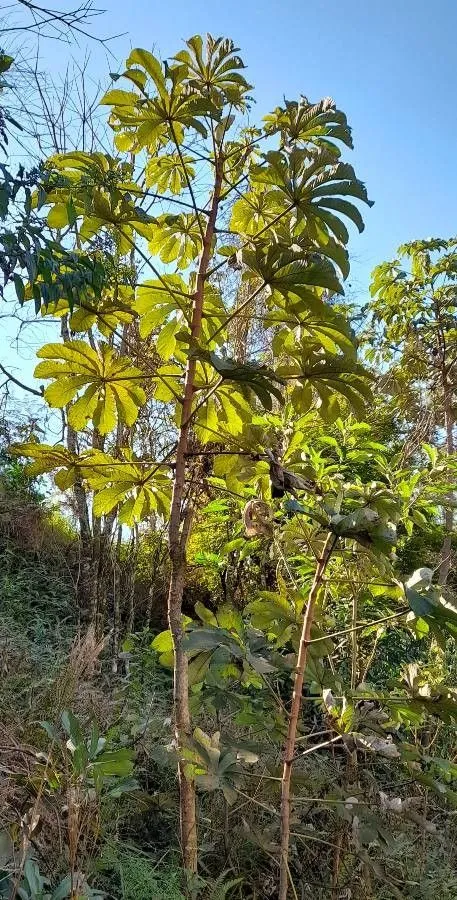
Author: Trécul
Bibliography: Ann. Sci. Nat., Bot. sér. 3, 8:80. 1847
Year: 1847
Status: accepted
Rank: species
Genus: Cecropia
Vegetable: False
Observations: Brazil to NE. Argentina
The Ambay pumpwood, scientifically known as Cecropia pachystachya, is a notable species within the Urticaceae family. First described by botanist Trécul in 1847, this plant has earned recognition in the botanical community for its distinct characteristics and widespread distribution.
This resilient and adaptable species is endemic to South America, with its natural range extending from Brazil to northeastern Argentina. The Ambay pumpwood thrives in these regions, contributing significantly to the native ecosystems.
As a member of the Urticaceae family, Cecropia pachystachya shares several common traits with its relatives. It typically features a fast growth rate and prefers tropical environments where it can receive ample sunlight and moisture. The plant is easily identifiable by its distinctive structure and foliage, which make it an integral component of its native habitat.
In its natural environment, the Ambay pumpwood plays a crucial ecological role. It provides shelter and food for a variety of wildlife species, thus supporting biodiversity. The plant’s leaves, rich in nutrients, are particularly beneficial to certain insect species and other herbivores, contributing to the dynamic food web of the regions it inhabits.
Moreover, this plant holds cultural and practical significance in the areas it grows. Locally, it has been used traditionally for various purposes, including medicinal applications. Its presence in the landscape is valued not only for the ecological benefits it brings but also for its contribution to regional heritage and potential uses in folk medicine.
In summary, the Ambay pumpwood (Cecropia pachystachya) is a vital plant native to South America, known for its adaptability, ecological importance, and traditional uses. Its study and preservation continue to be of interest to botanists and ecologists, as it remains a key species within its native range from Brazil to northeastern Argentina.
Eng: ambay pumpwood
Por: embaúba, embaúba-branca
En: Ambay pumpwood
Pt: Embaúba, Embaúba-branca
© copyright of the Board of Trustees of the Royal Botanic Gardens, Kew.
© copyright of the Board of Trustees of the Royal Botanic Gardens, Kew.
© copyright of the Board of Trustees of the Royal Botanic Gardens, Kew.
Taken Jul 24, 2021 by Trap Hers (cc-by-sa)
Taken Jul 24, 2021 by Trap Hers (cc-by-sa)
Taken Jul 24, 2021 by Trap Hers (cc-by-sa)
Taken Apr 24, 2022 by Makoto Makoto (cc-by-sa)
Taken Feb 2, 2020 by Kempes Thiago (cc-by-sa)
Taken Jul 24, 2021 by Trap Hers (cc-by-sa)
Taken Jul 24, 2021 by Trap Hers (cc-by-sa)
Taken Mar 10, 2022 by Thiago Flores Flores (cc-by-sa)
Family: Myrtaceae Author: (F.Muell.) K.D.Hill & L.A.S.Johnson Bibliography: Telopea 6: 402 (1995) Year: 1995 Status:…
Family: Rubiaceae Author: Pierre ex A.Froehner Bibliography: Notizbl. Bot. Gart. Berlin-Dahlem 1: 237 (1897) Year:…
Family: Sapindaceae Author: Koidz. Bibliography: J. Coll. Sci. Imp. Univ. Tokyo 32(1): 38 (1911) Year:…
Family: Asteraceae Author: A.Gray Bibliography: Pacif. Railr. Rep.: 107 (1857) Year: 1857 Status: accepted Rank:…
Family: Fabaceae Author: Medik. Bibliography: Vorles. Churpfälz. Phys.-Ökon. Ges. 2: 398 (1787) Year: 1787 Status:…
Family: Aspleniaceae Author: (Cav.) Alston Bibliography: Bull. Misc. Inform. Kew 1932: 309 (1932) Year: 1932…